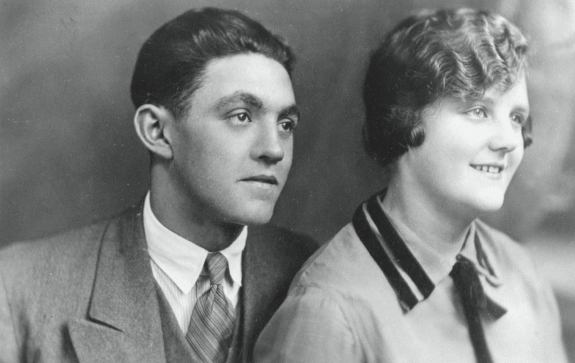
3
May, my New Career &
a Tour of the Market
My dear sister May was very deaf. An attractive blonde, eighteen years old and with a nice figure, she worked very hard and long hours in a steam laundry. May had very little time to herself, but was addicted to ‘the talkies’ as we called them. She was a regular patron at the Pavilion cinema nearby, and had the advantage of knowing two of the staff, the commissionaire, Mr Ferry, and his usherette daughter, who rejoiced in the name Hepzibah. These two always gave May their best attention.
Following visits to the cinema, Hollywood fashions became a magnet for May’s hard-earned savings. Such styles were not to be found in Poplar. The only shop women had locally still sold whalebone stays and blue, fleece-lined knickers, described as their ‘best-sellers’. The only places to get styles similar to the movie stars were in Aldgate and Petticoat Lane. Shops here obtained garments from West End stores, copied them and freely displayed them ‘straight from the USA’. This was where May shopped, and I acted as her interpreter, on account of her deafness; my constant allegiance was usually rewarded with a small coin, or a promise of one. When savings allowed, on a Sunday morning, we would set off on the Number 67 tram to Aldgate. If it was raining, so much the better, as better prices could be obtained: such days were the best-selling days in the Jewish calendar. After peering in window after window at the fashions on display, ignoring the barker who always claimed at the top of his voice to have the ‘biggest range in the market’– this was to intimidate his rivals – we would enter the most promising-looking store and browse the selections.
Everything had to be compared for colour, size and style. Bust and waist measurements were Greek to me at the age of ten. If she decided that she had found what she wanted, May would signal to me by placing her hands together with the two thumbs pointing upwards, before moving towards the door. This flummoxed the poor salesman, who thought a sale was getting away, and in desperation he would lower the price. May would then open her purse, so he could see she was serious, and demand a still lower price. This clinched the bargain, and she would leave the shop with her trophy in the shop’s own bag, only to transfer it shortly afterwards to a plain shopping bag so no one at home would know where she had been. If there was nothing she desired, May would signal me to leave first, then rise from amid the pile of try-ons and exclaim that she had to go now, in case I got lost! There was no chance of that.

The author’s elder sister, May, was profoundly deaf. This did not, however, stop her from visiting the cinema, where she was friends with the commissionaire’s daughter, or from shopping ruthlessly for the latest fashions. She is seen here with her ‘dream husband’ darts champion Eddy (Monty) Doughty.
Next, shoe shops were explored for the matching styles, shapes and heels that would suit her other purchases, and we sat for ages amid a growing pile of boxes until a suitable pair could be found. With another prearranged signal from May, I would note the size and style on the preferred box, and then May would sigh and remark sadly that they were not what she wanted but we might ‘come back later’. The poor shop girl would have to put all the boxes away again; so that, when we did return the next week, or whenever funds permitted, she was so pleased to be asked for the ‘right’ pair of shoes straight away, that she was happy to accept a lower offer. On our way home, Assenheim’s ice cream would be devoured triumphantly, in time for Sunday lunch.
All togged-up and out to visit friends, May was admired by a fleet of young and old alike. Some would ask if she was courting, and where had she bought her lovely dress? When May did find the man of her dreams, she could not have made a better choice; a devoted husband for life. My work as an interpreter was over, I was ten years old and unemployed, with only my memories of a beautiful, kind sister so sadly afflicted by deafness.
MOTHER’S YOUNG WAGE-EARNER
A month before my fourteenth birthday I was summoned from class by a shrill whistle to go to the Headmaster’s study. Nervously passing the hall where the choir were practising for the Christmas carol service, I wondered what I had done wrong. Had I put the money for Sprackling’s new cap on the Headmaster’s desk, as I had been asked to? Yes, he had locked it in the cashbox in his drawer. I knocked at the door, and waited for permission to enter. This seemed to take longer than usual, but at last I went in and found a tall, fair-haired, spotty-faced young man already there. This was Bill Williams, who had left the school two years earlier and found a job. He had so impressed his boss with his progress that he had been sent back to Culloden School on a mission to find another suitable lad to fill his boots, as he was being promoted. Was I interested?
I had not yet thought about finding a job. I was more interested in my approaching birthday, which happened to fall on Christmas Day. But the Head asked me if he could trust me to keep up the good name of the school, I told him I could, and it was arranged then and there that I should go along the following day and report to Billy’s boss. At worst, I thought, it would be a day bunking off school.
Outside the door, Bill explained all about the job and I anxiously prompted him, knowing that I would be thoroughly interrogated by my parents and my four brothers and two sisters well before I arrived at the offices of Messrs W.B. Bawn & Co. Ltd. At 9 o’clock the next morning, I set off for 47, West India Dock Road to meet the boss. I was shown through a noisy workshop with dozens of men and boys, all in work clothes. Some wore boiler suits, which I knew denoted their special rank. We went through a little house in the next street, Castor Street, behind the first workshop, and entered a second, which was the welding shop. Flashes of brilliant blue light were punctuated by heavy, metallic thumping noises. Bill knocked at the door of an inner office and there was my new boss, Mr Harold Hindle, a round-faced, heavily built man wearing a battered fawn trilby hat and the white, starched collar and tie that made his managerial status official.
Questions flowed thick and fast. I had to explain that I was lame owing to meningitis and infantile paralysis, although Bill had probably already told him. He gave me a writing test and some easy mental arithmetic, which I answered to his satisfaction. Much to Bill’s delight, this brought an immediate offer of a job; he was keen to offload all the menial work he had been saddled with for the past two years! The wages and hours were: 10s 6d per week, 8 a.m. until 5.30 p.m., Mondays to Fridays, and 8.00 until 12.00 on Saturdays. One week’s paid holiday and a review each March, with a promise of a small bonus at the end of the financial year. I was to start work the week before Christmas, if the school was happy, and would be given assistance until settled.
Mother was waiting anxiously with a cup of tea. The regular wages would help with the family’s finances and she was delighted that her young ‘crippled’ son was off her hands and working for a living. My father was naturally full of questions, and delighted too, as he had worked with Bill Williams’s dad in the docks for many years and knew him well.
The room that I had my desk in was opposite Mr Hindles’s office and for a while I shared it with Bill until I knew the job reasonably well. He was moving to the main office, the next rung on the ladder; although for many months he was back and forth across the factory seeking information from the platers’ foreman or the electric arc welding foreman, whom I shared the office with. From them I learned to grow up very rapidly in the engineering world and thus, from the job of office boy, went on to become internationally known and, hopefully, respected in the steel industry.
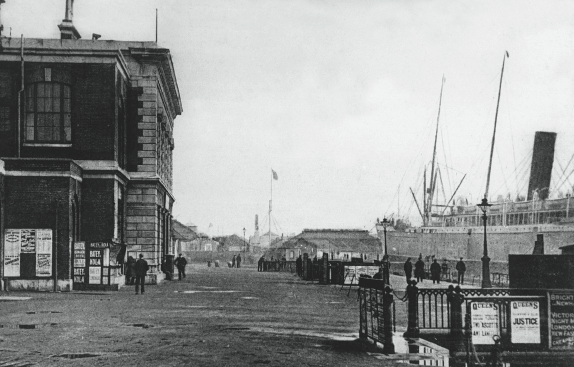
Poplar’s Brunswick Pier: a view of the London and Blackwall Railway terminus with the steamer Braemar Castle entering East India Dock. Opened in 1840, the pier was demolished in 1947. ‘Batey Kola’, advertised on the kiosk, was a popular drink.
FIRMS AND EMPLOYMENT
A large number of men and women owed their livelihood to the local firms that were founded and grew up in Poplar and the surrounding area. They were able to work close to home, saving the fare and enjoying more free time. Neighbouring Millwall was a hub of industry and activity. C. & E. Morton’s Jams and Preserves was a clean, pleasant factory employing mostly young women, all neat and tidy in the overalls with which they were provided – a great contrast to the young lads who worked at Vince’s Dry Battery factory in nearby Garford Street. They went through the gates at the start of every shift, nice and clean, and came out looking like ‘Kentucky minstrels’. The adjacent foundry of C.W. Gill saw an endless stream of barrows going through the weighbridge, each load of scrap iron that the rag and bone men had collected being carefully checked. The furnaces spewed out columns of dark smoke when first lit.
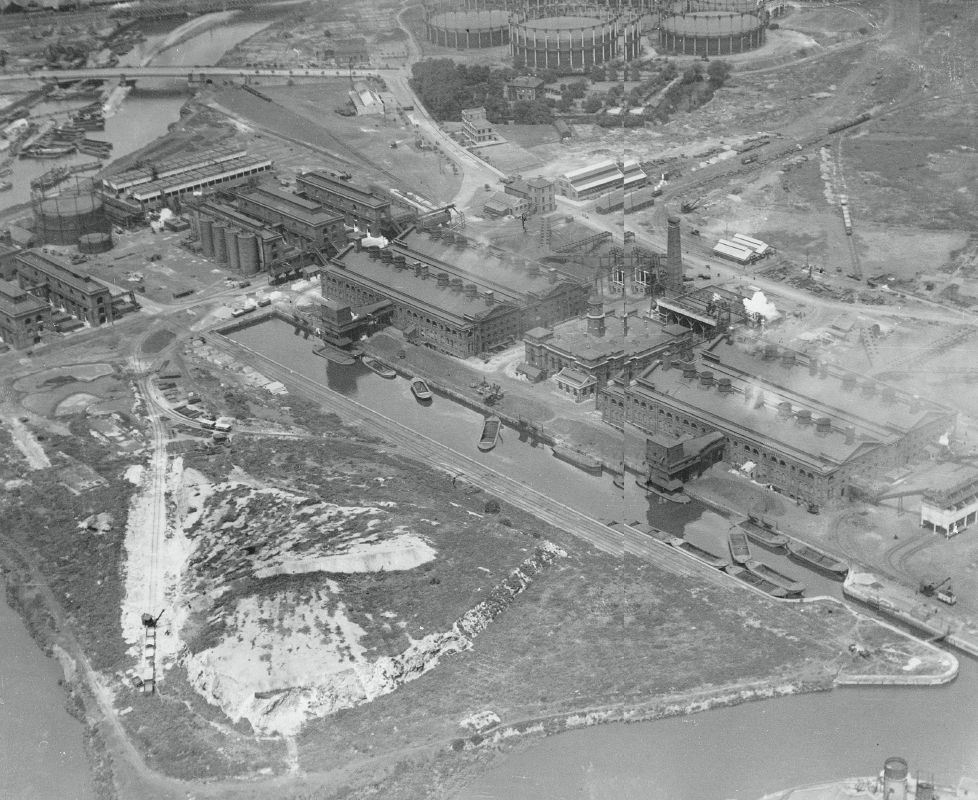
An aerial view of the Bromley Gasworks, Bromley-by-Bow, 1920s or ’30s. In the foreground is the River Lea. Built in 1873, the gasworks operated until the 1970s when coal gas was replaced by the cleaner North Sea variety. On the right of the picture two-thirds of the way up was the location of the author’s offices and ‘temporary home’ for four years during the war.
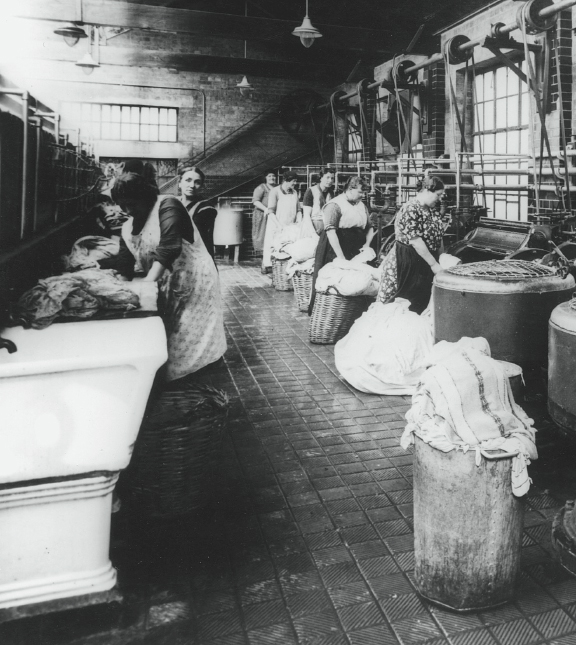
Women loading laundry into the big washing tubs at the public washhouse in Sophia Street. The mechanical washing section was opened in May 1931. These women would earn a few pence taking these huge loads for neighbours and customers.
J. Kirkcaldy, ships’ plumbers, and Houchin, electricians, were nicely placed next to the docks for taking on emergency repairs. The famous Hawkins rope mill employed highly skilled craftsmen turning out very large mooring ropes, twisting and turning the hemp expertly on the rope walkways. They also produced smaller versions, for instance for the Brixton prison hangman. John Lenanton, timber suppliers, were also ideally sited on the river. Barges could bring and unload timber from all over the world. Burrell’s paint factory was close to the petrol tank makers, John Bellamy. Both firms employed skilled men for the heavy work involved, as did the bridge builders, Joseph Westwood, recognised during the Second World War more for their tank landing craft, which were launched on the Thames.
Gasometer makers Samuel Cutler were busy in the 1920s welding and repairing the huge town-gas holders that were once prominent throughout the UK, before North Sea Gas. The much-photographed Oval gasholder was maintained by them. Millwall was also the home of the ubiquitous Sterling washing mangle, known by every housewife in pre-spindrier days as an instrument of hard labour.
From the road in West India Dock could be seen the life-sized figure of a ship’s helmsman, complete with wheel. This figure, the trademark of W.E. Brown, tankmakers, withstood the rigour of the war years, and is still intact, presiding over their new factory in the Eastern counties. Brown Lennox and W.E. Moore employed teams of experts, who toured the capital and its suburbs testing chains and lifting gear in factories to certify them as safe. The Factory Acts Safety First Procedure was a forerunner of today’s Health and Safety legislation. One of the finest coppersmiths in London, Blundell’s were kept busy by the breweries and the confectionery trade. Richards & Sons was a small, family-run business known as a fine firm of tinners. The father and four boys were always hard at work, cleaning and re-tinning hundreds of pots, pans and cauldrons for the home, export and shipping trades.
Missing the opportunity to set up in nearby Barking, Spratt’s Dog Biscuits employed dozens of women, young and old; indeed, they also supplied the Armed Forces and shipping companies with ‘hard tack’ emergency rations for lifeboats. These were bullet-hard and lasted for years, but they saved lives. Nicer, more edible table assortments were produced at the far-famed biscuit factory nearby, where children hung around at going-home time, hoping for a few broken samples. The famous Lloyd Loom furniture was invented and made in Poplar, using a unique method of construction. Strands of thin wire tightly wound with paper were ‘woven’ into chairs, baskets, stools and ottomans, apparently the widest range ever produced by one furniture company. The items were spray-painted, in colours attested to by the wide range of shades apparent on the workmen’s overalls after each shift. Another part of the company produced drinks crates for the brewery and soft drink trades, in an age before throwaway bottles became the norm.
The Emu Wine Co. was something of an oddity, importing Australian wine in bulk and bottling it for the UK market. Not a lot was drunk locally, Poplar folk were more your ale and bitter types. The Sun flourmill was an ancient building on the canal. Even hours of rain never seemed to shift the ghostly sheen that coated both the employees and the district when the wheels were grinding. Saul D. Harrison’s rag mill was a dreary building, taking in old rags to be washed, dried and then chopped and sheared into small pieces. It produced what was known as ‘prime flock’ for use in the bedding and upholstery trade. This firm later imported large blocks of solid packed fibre and broke them up, beating and teasing them into bags of loose fibre filling. The employees wore masks over their mouths and eyes and were permanently covered in a reddish dust. They earned every penny of their wages doing a dirty and dangerous job few would willingly undertake.
The firm of Cairda and Rayner was world-famous in shipping circles, manufacturing desalination equipment that provided fresh drinking water for ships’ crews, half an ocean away from the nearest port. Another firm where craft skills were appreciated was Bright’s in Rhodeswell Road, who still made the carts and wheelbarrows used by traders all over London. These were brightly painted and carved from various woods. After rubbing down, many coats of varnish needed to be applied. The market traders’ signboards with their gilt-edged lettering had their origins at Bright’s. Hitchman’s dairy in Kirby Street employed a small army of roundsmen, pushing their familiar three-wheeled milk floats through the streets of Poplar, a large milk churn perched in the centre of the cart. The noise of their clattering could be heard from a great distance. The milk came fresh from the stalls in the dairy yard, where the cows would be stationed and then let out to graze in some local park. ‘Accidentally’ leaving the lid off the churn brought the roundsman a heaven-sent bonus on rainy days.
George S. Clayton’s dairy was also nearby; the company is still in business today. It was a delight to go and watch the intricate bottling plant at work. With dozens of smaller businesses and self-employed craftsmen and tradesmen, Poplar employed thousands of men and women and their skills gave us numerous products of the highest quality. These skills were handed down to the young, making Made in Poplar a trademark to be proud of.
CHRISP STREET
In my memories, I often wander through Chrisp Street market. At the East India Dock Road end, where the market begins, is Burgess’s Fruit Stall, with the polished brass rails, signwritten and varnished nameboard, the prices neatly displayed. Brown paper bags, stretched over cardboard, form the price tickets that are marked with prices in Rickett’s Blue, each atop its pyramid of scented fruit. Here too is the ladies’ hatshop – some straw, some veiled and in a variety of colours. Not quite next door is Manzi’s famous eel and pie shop, with its tanks of live eels for the shop or the passing trade and next to it, Udal Bros’ shellfish stall: crabs, winkles, cockles, scallops and jellied eels, always clean and fresh-smelling of the seashore, next to the bottles of Sarson’s vinegar on display. Opposite was a wonderful stall, always colourful, with flowers of every description. This was carefully created by Mrs Briggs, who made an early journey to Covent Garden, sometimes to complete a wreath order for a customer. Gallons of water were poured on the blooms to keep them fresh. Her stall was outside the True-Form shoe shop, which enabled her stall to be lit for free.
On the opposite corner with Susannah Street is the original of the famous chainstore, Burton’s Tailors. Outside, the Salvation Army band plays, while Army lasses sell copies of War Cry. In their absence, buskers, barrel organ-grinders or even chained-up escape artists would perform – but only if there was enough in the hat. Facing the flower stall is a dinky little Woolworth 3d and 6d store, newly opened. A pair of slippers costing in reality a shilling were priced at 6d each slipper, rather than confess that anything there cost more.
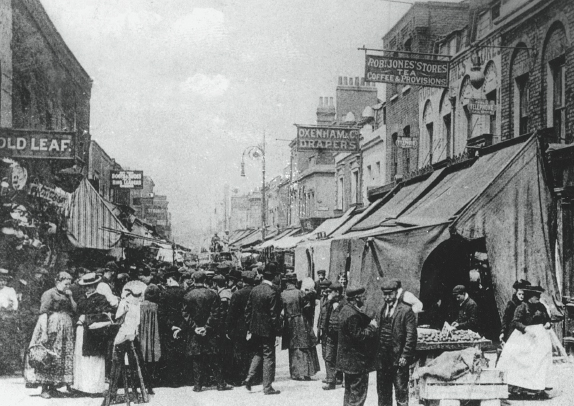
Chrisp Street market, c. 1910. Grundy Street fruiterer, Edward Green (d. 1935) pioneered the market with his brother. When the street traders were forced out of Poplar High Street in 1878 at the request of the shopkeepers, he set up his pitch outside Oxenham’s drapery store in Chrisp Street.
Outside Woolworth on a Saturday evening, you would find a sweet stall run by a man named Goldie, on account of his two front teeth, which were solid gold. Under his flaming kerosene lamp he would mock-auction boxes of sweets and chocolates of unknown or obscure origins, knocked down at low, low prices. Moving along, we come to the market favourite, Piper’s Cooked Meat shop and stall. Pease pudding, faggots, saveloys, trotters, black pudding, tripes – and the scary half-sheep’s head, all steaming and a great provider of an East End supper for some late-working family. Facing this was the children’s dream stall: Pearson’s Home-Made Sweets, wonderful smells of cough candy, coconut ice, bull’s eyes and brandy balls, displayed for all to see.
A row of three shops is occupied by Harry Neave, the big furniture and furnishings outfit. Rolls of linoleum and cheap oilcloth, chairs, perambulators and beds stand outside on the pavement, chained for security. Facing them, Oxenham’s, the drapers, reminds me of Grace Brothers in Are You Being Served?, the assistants uniformed in black, with white collars. The cash for your purchases was put into a wooden ball with the receipt, and elevated up a wire railway to the cash desk, from where you waited for it to be returned with your change. A farthing change would come carefully wrapped in pink paper, folded with pins. All the prices were something and three farthings, never just sixpence or a shilling.
Busy little Endeans, the leather shop, is a regular trip for most families to buy shoe leather and rubber heels to mend the family’s shoes; together with Blakey’s protectors to try to prevent the rapid wear that children with home-made scooters, particularly, soon produce on one boot.
Between the stalls and the shops roam the street vendors, trays suspended from strings over the shoulder, displaying shoelaces, lavender bags, little white sachets of horseradish. Now and then a war veteran, perhaps blind, offers boxes of matches on his tray that you can take, or leave a copper to help. Medals – the Mons Star in particular is much in evidence and recognisable to most people. Bundles of best elastic and packets of ladies’ hairpins for a penny or two help these forgotten heroes to get a bare living.
The next shop to Endeans sells a variety of shirts, underwear, ties and scarves, and loose collars with fashionably long peaks, all the rage in the 1920s and ’30s. Across the street is a well-known provision merchant, Coppen’s, whose assistants pride themselves on knowing dozens of their customers by name – as well as their individual requirements, bearing in mind that cost-consciousness would always endear such customers to their particular brand of service. Bacon, biscuits, cheese and eggs are among the dozens of lines stocked. Part of the counter bears a dozen or so glass-topped tins, showing the various biscuits and the price per pound. Broken biscuits are sold in bags, quality and type unknown until you unwrap them. Eggs are always handled separately and placed carefully in brown paper bags, to be carried gingerly on top of the shopping.
Further on still, are the arch-rivals of the Burgess stall, Fitch’s. Despite being fully a quarter-mile apart, each was constantly sending touts and lookouts for a small fee, to report on the other’s prices. Near them is the first of the fresh vegetable stalls run by the Softley family, the boys well-known in East London boxing circles, hardworking tradespeople and well-respected. The Pot Herb lady, too, was respected for her little barrow offering a selection of carrots, onions and turnips, set out on a tin tray in quantities sufficient for a local stew known as Sukie. Next comes a very large stall plastered with books, comics and magazines for every interest, mainly suspended on clothes pegs so you could browse the titles, but not the contents. This is run by the Ballard family, obliging and well-informed on most topics, and willing to procure you anything – love, crime, mystery, adventure – if not in stock.
Wallace’s is a marvel for its display of china, buckets, brooms, mats and cutlery, just a few of the items on offer with a notice informing you that ‘a small deposit secures’. Boots the Chemist is just a small, efficient shop on the corner of Southill Street, where a group of ladies is surrounded by a large crowd, waiting to see what items are held up from a mountain of secondhand clothes on the pavement. Hands reach for a garment ‘suitable for a girl or boy of six years old’ – or a small nine-year-old – at the knockdown price of 3d. This pavement raffle helped to clothe many a junior member of the large, impoverished families prevalent in those days.
Overlooking the market, mounted on a roof, is a very large, red teapot. Beneath it, ‘Tea Pot Jones’ is a master provisioner, a wholesaler supplying the market and delivering to the many corner shops in the district, in the days before cash and carry warehouses. Next to him is the ‘one and only’ wet fish shop, its marble slabs awash with water and bits of ice. Long, hanging rows of yellowy smoked haddock and brown kippers gaze down on generous cutlets of conger eel and slabs of salted cod, cheek by jowl with herrings and bloaters: enough to suit everyone’s pocket and tastes. Outside this shop, an unusual stall exhibits rolls of the new American cloth, in various colours and designs. This ‘gingham’ oilcloth was sold by the yard for covering the wooden kitchen tables in everyday use and was, of course, washable. Narrow strips would be used as overmantel covers, the little shelf above the fireplace, and no doubt brightened the kitchen with their cheerful colours.
One of the busier shops comes next along the market, Batch’s. Dozens of crates of eggs were laid open and the various sizes priced. These were imported from Poland and Denmark, nestled in wood shavings. Those that came cracked were sold in large trays at knock-down prices – 9d and 1s per dozen. There was a brisk trade in eggs sold loose in bags (no boxes or cartons in those days). Opposite the egg shop is one of the real characters of Chrisp Street market, Ernie Pike, the open-air butcher. With no shop, he can be heard calling out eminently affordable prices for joints, bacon, chops, beef, pork and lamb. Most shoppers know to wait until last thing on a Saturday night to buy a joint for Sunday dinner, knowing that ‘Pikey’ would never let you go away empty-handed if it meant less meat to store until Monday. Nearing the end of the market, you might be caught by an amazing Jewish pavement salesman from the Best Goldstein shop. He would invariably have ‘your size’ at a ‘very special’ price, the item had ‘just arrived’ (even if it had been in stock for months). He never went into the store himself, just called out that you were coming in – brilliant salesmanship.
Finally, there is Harris’s, the market’s only jeweller. Wedding rings, all shapes and sizes, are offered on velvet trays, together with a ‘free gift’ with every one purchased. Lines of Ingersoll watches with the latest luminous dials, a must to see in the dark. Harris was not a pawnbroker, though; that was Thompson, whose side door was open all day for customers requiring discretion. On Monday morning, the long line of pledgers, most of them regulars, would have something with which to pay the rent man, the coal merchant and the grocer, to keep their family alive, if not exactly well fed until payday. That is, if they could keep themselves from entering one of the six, very busy public houses found within a half-mile in the market, and as many more in the streets behind.
ST LEONARD’S ROAD
Leading off the East India Dock Road, St Leonard’s Road provided the residents of Poplar with more shops of every description. Starting on one side was the Commercial Gas Company, which occupied the long corner premises next to the family butchers, Mace, with its wonderful display of joints and a long rail of sausages. Raggett’s, the newsagents, was one of the busiest shops in the district, hosts of delivery boys being dispatched with the morning, midday, mid-afternoon and evening editions. These had to be out on time. The next-door shop was the immaculate Maypole, wonderful stamped designs impressed in the large blocks of yellow butter ranged on the marble counter. Your purchases did not come from these, but were cut at the back, shaped in small blocks and deftly placed on the counter by the assistant, armed with two paddles of wood which made wavy lines in the butter, which was then handed to you, wrapped in greaseproof paper.
Mrs Nunn was the florist and made the best floral tributes your neighbours could buy. Anderson’s, the wet fish shop, was manned by a cheerful crew of blue-aproned staff. Water was always left running over the fish – they weigh more when wet. Gates the tobacconist was a compact little shop that specialised in loose tobacco weighed on brass scales. If you asked him to, he would tip the tobacco straight into your pouch. Opposite Glasson’s the furniture store was Billy Wells, the catmeat man. His little shop was just a housefront, his sitting room filled with chunks of horsemeat, waiting to be sliced and chopped into small pieces. These were sold on skewers from a large basket as Billy toured the district, calling ‘Cat meat!’ If his knock went unanswered, the skewers would be left under the doorknocker, out of reach of all but the most agile cats.
The double-fronted Stevens’s provisions was one of the friendlier family shops in the neighbourhood. Next door was another children’s delight, a sweetshop, with especially low-built counters to enable the smaller ones to see and ponder their purchases for a while. They also sold twopenny ‘monster’ bottles of pop, that would be shared by two or three children. A large greengrocer and fruiterer, Hall’s took up three or four premises, boxes of fruit and veg coming and going at all hours. Mr Drake was the local street bookie, and he took advantage of the bustle around Hall’s to ply his trade. Street bookmaking was illegal, but Drake’s odds were never any better than those offered by Mr Ross, who operated just down the street.
Haines, the fried fish shop, always had a long line waiting to be served. Frying times would be announced on a board, and a penny bag of crackling – loose pieces of batter – was welcome when they cleaned out the large fish fryers. Perpetually crouched over his ‘hobbying foot’ sat Gallard, the local boot and shoe repairer, his mouth filled with tacks. The little woodshop, Paul’s, had racks of timber, boards and beading of every description. Cornelius, an old shop, sold pungent hay, wheat and fodder, plus all the feed mixes for fowl, rabbits, pigeons and pets. English, the drapery and furniture shop, was a boon to many families, offering credit by weekly payments in advance.
Just behind St Leonard’s Road was Culshaw’s dairy and shop. Children of shopping mothers liked to visit the immaculately clean herd of cows in the yard, which could sometimes be seen grazing in the local parks. Pchedborski, a name to be conjured with, was another favourite of local children, who watched him slicing and bagging bread – so different from the loaves wrapped in flimsy white paper you would get at the baker’s. Wimhurst, the Rolls-Royce of confectioners and ice cream makers, provided gorgeous sundaes in thick, conical tumblers with red cordial dispensed on the top. Another Anderson fish shop dabbled in wet fish, with the occasional fry-up; Yeo, the piano shop, displayed a good range of polished wooden instruments with weekly instalments offered to tempt the burgeoning middle classes.
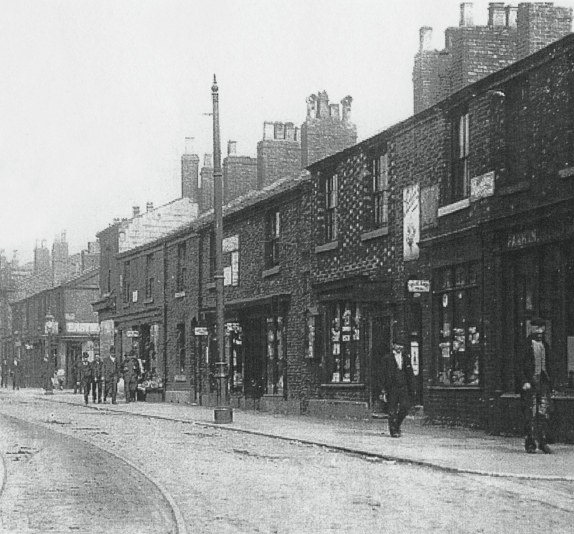
St Leonard’s Road.
With money in short supply, imaginative arrangements were needed, and Rawlinson’s the drapery ran a pay-as-you-wear scheme through local clubs. A double-sized shop, five or six assistants were always on call. Opposite was the solemn, double-fronted shop of Adams, undertakers. The management dealt sympathetically and with dignity with local folk at times of bereavement and were well-recommended; a window display offered a number of styles of inscribed headstones. More lively, if not exactly a ‘barbershop quartet’ – they were too busy clipping, shaving and nattering to sing – were the stylists at Sargent’s, the local barber. Looker’s, the ironmongers, was an Aladdin’s cave of oddities. If you could describe it, the assistants would find whatever you wanted; within minutes, a ‘thingummy that goes round like that and stands up at the back’ would be wrapped and your money taken. Reeves the stationers was much patronised for writing materials; notebooks, pens, pencils, blotting paper, bottles of ink in every colour and size. This was long before the ubiquitous Biro and the felt-tip pens of nowadays, and was a haven for students. A chemist’s shop and its next-door neighbour, an electrical retailer, concluded a shopping ‘precinct’ that had just about something for everyone.